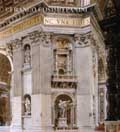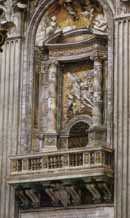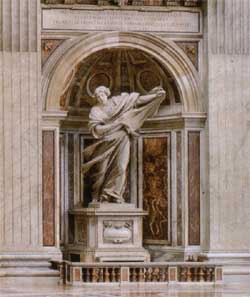| Grottoes
Vatican City Colonnade Saints Floorplan #2 |
| Altars
Monuments The History |
| Related
Items St Andrew Statue Veronica Statue St Longinus Statue |
 |
 |
 |
The display of St Veronica's veil from the relic niche above her statue. This and other relics are shown on the fifth Sunday of Lent in St Peter's Basilica. |
From:
'Guide to Saint Peter's Basilica'
Saint Veronica, was the poor pious woman whom Jesus cured, and who met
him again on the road to Calgary where she wiped his face when he fell
under the weight of the cross. Miraculously, he left the image of his
face on the cloth. The crusaders brought a "veil of Veronica" to Rome
from Jerusalem. It was highly venerated, especially during the Middle
Ages and was mentioned by Dante in the Divine Comedy (Paradise, XXXI,
104) and in the Vita Nuova (40,1).
From:
'St. Peter's Basilica - A Virtual Tour' by Our
Sunday Visitor
The arrangement and decoration of the pillars which support the dome,
as begun by Bramante and completed by Michelangelo, are another of the
most important works executed by Bernini between 1629 and 1639 during
the papacy of Urban VIII.
On the internal sides of the four pillars, which are 45 meters tall and have a perimeter of 71 meters, he created four large niches at the base with an upper round arch covered with multi-colored marbles, and above, four loggias, placing tabernacles at the bottom supported by spiral columns (those which supported the ancient Constantinian "pergula"), with high bas-reliefs depicting angels holding the symbols of passion. The two openings are connected by a protruding balcony and are crowned by a roof that resembles a curtain such as that from the Canopy.
This structure along with the front of the pillars forms a harmonious assembly. In the niches, Bernini placed four large five meters statues, according to the wishes of Urban VIII, all with emphatic and excessively theatrical postures.
The "St. Veronica" bearing the "Volto Santo" (Holy Image) is the most original and audacious of the four works due to its almost invading posture in the impetuous race in which the wind pins the clothing against the body.
This work received much criticism because of the excessive motion, which was not suitable for the subject or the location. This statue, that has similarities in the section of the clothing with other works by the artist, including his famous "Cavalli Farnesiani" of Piacenza, was the brunt of shrewd anecdotes. So it was said that when Bernini asked where such wind came from that moved the clothes of the Saint, Mochi answered sarcastically: "from the cracks that were opened by your ability in the dome."
In fact, at that time rumor had it that Bernini, while digging in the pillars, had created some dangerous cracks in the work by Michelangelo. Afterwards, with the decline of the artist's fortunes, under the papacy of the moralist Innocent X, who was famous for having covered the nudity of various works of art, a commission was established in 1680, which also included some of the master's students, to determine if the pillars of the dome had been damaged. An accusation that time demonstrated to be unfounded, but the envy for the success of others and the alternating favors of the Popes, had to produce vicious backbiting, leading to sarcastic statements but also material damage.
From: 'Guide to
St Peter's Basilica' © 2003, Libreria Editrice Vaticana
On 18th April 1506 Julius II placed the first stone of the new Vatican
Basilica in the foundations of the pier of the Veronica. On a side was
written: Julius from Liguria, Pontifex Maximum, in the year 1506 restored
the Temple of St Peter in Vatican from the foundations, deteriorated for
age and position.
From: ' Pilgrims
in Rome' © 1999, Continuum
The symbolic image of the pilgrimage to Rome is Christ's portrait
on a piece of cloth; hence it name of 'Veronica', from vera icona,
meaning 'true icon'. As the Sudarium Christi (Christ's Kerchief),
it has been venerated during every Jubilee since 1300 by pilgrims, to
whom it is exhibited on Fridays and holy days,and it is one of the three
most important relics in St Peter's; the other two are a fragment of the
Cross and the spear that pierced Christ's chest. From the twelfth century
onwards, it became generally believed that the venerated relic was the
veil with which, according to tradition, Veronica dried the sweat on Jesus'
face as he climbed the sloped of Calvary. The cult of this icon was given
a considerable stimulus by Innocent III when in 1216 he saw the veil turn
over in its reliquary after the customary 'Procession of the Veronica'
from St Peter's to the Ospedale di Santo Spirito. Believing this was a
sign, the Pope wrote a prayer which gave an indulgence of ten days (the
first instance in history of a prayer connected with an indulgence). Dante
saw this relic during the 1300 Jubilee, and extols it in Paradiso XXXI,
103-108, and Petrarch makes a significant reference to it in the Canzoniere,
XVI.
Other Sources
The woman of Jerusalem who wiped the face of Christ with a veil while
he was on the way to Calvary. According to tradition, the cloth was imprinted
with the image of Christ's face." Unfortunately, there is no historical
evidence or scriptural reference to this event, but the legend of Veronica
became one of the most popular in Christian lore and the veil one of the
beloved relics in the Church. According to legend, Veronica bore the relic
away from the Holy Land, and used it to cure Emperor Tiberius of some
illness. The veil was subsequently seen in Rome in the eighth century,
and was translated to St. Peter's in 1297 by command of Pope Boniface
VIII.
Nothing is known about Veronica, although the apocryphal Acts of Pilate identify her with the woman mentioned in the Gospel of Matthew who suffered from an issue of blood. Her name is probably derived from Veronica, as was reported by Giraldus Cambrensis. The term was thus a convenient appellation to denote the genuine relic of Veronica's veil and so differentiate from the other similar relics, such as those kept in Milan. The relic is still preserved in St. Peter's, and the memory of Veronica's act of charity is commemorated in the Stations of the Cross. While she is not included in the Roman Martyrology, she is honored with a feast day. Her symbol is the veil bearing the face of Christ and the Crown of Thorns.


